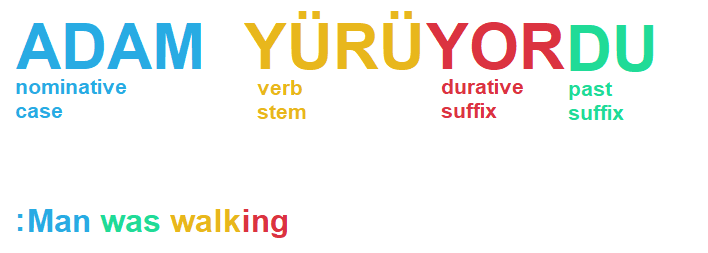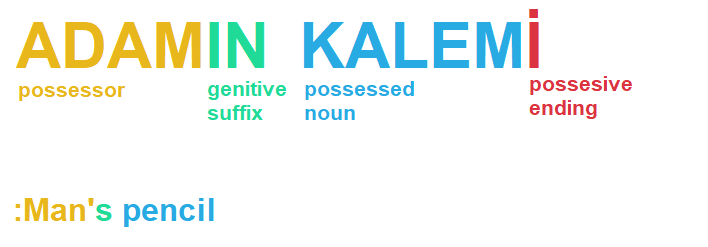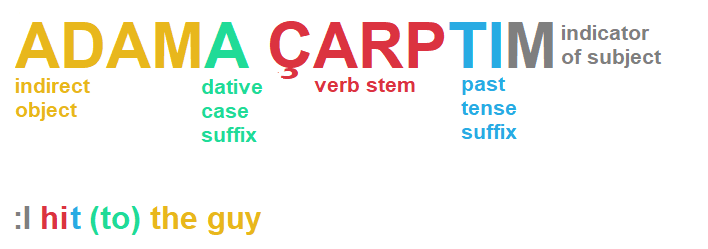If you are native English, Turkish grammatical cases might look like an alien at the beginning. Because English has lost its grammatical case system by time. (Unlike its cousin German language) In modern English, only personal pronouns and a couple of words have case systems. Let’s see what are these cases so that you’ll understand better the logic behind the grammatical cases.
| Nominative Case (Subjective Case) |
Dative Case and Accusative Case |
Genitive Case Possesive Case) |
|
| ENGLISH | I | Me | My |
| TURKISH | Ben | Beni/Bana | Benim |



It’s that simple. Let’s recap.
Grammatical cases, when attached to nouns, they indicate direction, location, possession etc. Romance languages such as Spanish, French etc. or English have lost their case system but some languages including Turkish, Russian, Finnish, German, Estonian still use an extensive case system.
Six grammatical cases exist in Turkish whereas this number is fourteen in Estonian, fifteen in Finnish and eighteen in Hungarian. Another reason to be grateful to the Turkish language because it only has six different cases(!) Only six!
Anyway, let’s explain how to use these Turkish grammatical cases. (You are making an introduction. We’ll explain the function and uses in detail at the end)
Case suffixes are attached to Turkish nouns and depending on the suffix attached, meaning changes. See with this basic examples:
! Absolute form: Bilgisayar

Bilgisayar çok yararlıdır
Computer is very useful
! Accusative case: Bilgisayarı
Bilgisayarı bana ver
Give me the computer
You see, English doesn’t use accusative case, or any suffix. But Turkish uses a suffix. -ı.
But why? If we say “Bilgisayar bana ver”, can’t we convey the same meaning?
Answer is NO.
If we say “Bilgisayar bana ver”, it means “Give (it) to me, computer”. That “ı” indicates “bilgisayar” is the object in the sentence and it is a definite object. As you see, Turkish nouns don’t have article, but accusative case is used if the object is definite.
! Ablative case: Bilgisayardan
Ses bilgisayardan geliyor.
Noise comes from the computer.
! Locative case: Bilgisayarda
Bütün dosyalar bilgisayarda.
All files are in the computer.
! Instrumental case: Bilgisayarla
Bilgisayarla hesap yap.
Calculate (with) the computer
! Dative case: Bilgisayara
Bu bilgisayara gönder
Send to this computer.
Turkish logic is:
Don’t use extra word, use suffixes instead and add these suffixes after nouns. What an agglutinative language!
Now, you understood the logic behind it. These case suffixes are attached after Turkish nouns and changes the meaning. You’ll learn more about each case but let’s talk about Turkish nouns a little bit:
Unlike romance languages or German, Turkish is a gender-neutral language. Grammatical gender doesn’t exist in the Turkish Language. The gender of a noun (or third person singular) can’t be understood unless it is indicated. Specific words are used to indicate the gender of a person or an animal.
What does this previous paragraph mean?
It means feminists would like to talk in Turkish. (Really?)
Well, In Spanish for instance, ‘chico’ means ‘boy’ and ‘chica’ means ‘girl’ but in Turkish, such a pattern for gender doesn’t exist. Actually, even articles don’t exist in Turkish. (In german der das die, Spanish el la etc). Instead, you use accusative case to make nouns definite.
Some names are unisex!
Because of the formality in the work environment, “Bay” and “Bayan” must be used to indicate gender. They are the equivalents for “Erkek” and “Kadın”, respectively.
By adding “ler” or “lar” to singular nouns, you create plural nouns.
Baylar (pl.), Beyler (pl.)
Men, Gentlemen
Bayanlar (pl)
Ladies
Baylar bayanlar or Beyler bayanlar
Ladies and gentlemen
You have seen grammatical cases on words ending with consonants so far. (Bilgisayar)
As long as the absolute form of the noun ends with a consonant, the same rules apply. In other words, to form a case, the suffix of the case is simply attached to the ending.
But, some words end in vowels so they need something: BUFFER LETTER!
Let me introduce you the buffer letter: “y”. Isn’t it a beautiful letter?
Y
Did you know that Spanish people call this letter ‘i griega’ which means ‘Greek i’.
Anyway, this buffer letter is essential if we are dealing with a noun ending in a vowel. But why?
Araba
Car
Let’s attach accusative suffix –i : Arabaı
Okay now, you have to learn something very important about the Turkish language: two vowels together don’t get along with each other: “Arabaı”
Sequence must be like this: CVCVCV (Consonant+Vowel+Consonant+Vowel etc.)
So, the buffer letter, y, comes between vowels and helps us to form a beautiful Turkish word: Arabayı. (Accusative)
Actually, there are two more buffer letters in Turkish. But we should talk about those letters later. Because this “Greek y” gets a bit jealous when we talk about other buffer letters.
So, if “Arabayı” is the form that took accusative case, “Araba” must be absolute form, right? Let’s talk about the absolute form:
1 Absolute Form in Turkish
The absolute form also corresponds to the nominative, vocative, and indefinite accusative cases in Turkish.
What you should understand from this sentence: If you were learning Finnish or Hungarian, you’d have to learn more suffixes for these cases too. But now, absolute form covers nominative case, vocative case etc.
1.1. Nominative case:
If a noun is the subject of the verb ‘to be’, then the absolute form of that noun is used.
Nominative case example:
Öğretmen onları gördü.
Teacher saw them.
Kedi uyuyor.
Cat is sleeping.
1.2. Vocative case:
Even though some experts don’t consider the vocative case as a case, we assume that it exists and is a case. And also, Pluto is a planet. Poor Pluto! Don’t play with his feelings!
Vocative case example:
Günaydın, anne!
Good morning, mom!
Yes, some languages like Polish distinguish nouns when it’s vocative.
1.3. Indefinite:
You have learnt that Turkish does not use any article. Instead, the accusative case suffix is used to indicate whether the noun is definite or not. If the noun is indefinite, the absolute form is used.
Indefinite example:
Kerem kitap aldı.
Kerem bought a book.
OK, so far we have not covered any of these 6 grammatical cases by the way. You have just seen absolute form. So let’s start with accusative case but before check this table where you can find the suffixes of turkish grammatical cases:
| Cases | Suffix | Example ending in consonant |
Example ending in vowel |
| Absolute Form | Ev | Araba | |
| Accusative Case | -I | Evi | Arabayı |
| Dative Case | -A | Eve | Arabaya |
| Locative Case | -dE | Evde | Arabada |
| Ablative Case | -dEn | Evden | Arabadan |
| Instrumental Case | -(y)lA | Evle | Arabayla |
| Genitive Case | -(n)In | Evin | Arabanın |



These are the Turkish case suffixes. All you need. Also, you are seeing another buffer letter here on the table. Did you guess which one?
N
Otherwise it was going to be: Arabaın
It prevented a catastrophe! Thank you ‘n’.
Accusative case in Turkish. (-i)

Let’s focus what is this “accusative case”:
Functions of Accusative Case:
1.Accusative case suffix is –i.
2.The first and most important function of Turkish accusative case is to make the nouns definite.
3.Some verbs need to go with accusative case.
You use accusative case if:
The object is a proper noun
The object is in genitive form
The object is a pronoun
Accusative case in Turkish – Examples:
Kedi gördüm
I saw a cat
Bir kedi gördüm
I saw a cat
Kediyi gördüm
I saw the cat
Bu kediyi gördüm
I saw this cat
Kedini gördüm
I saw your cat
Dün seni gördüm
I saw you yesterday
Müze gezdim
I visited museums
Müzeyi gezdim
I visited the museum
İstanbul’u gezdim
I visited Istanbul
Bu filmi çok seviyorum
I like this movie
Çorba içmeyi seviyorum
I like drinking soup
Film izlemeyi seviyorum
I like watching movie
Seni seviyorum
I like you / I love you
Kerem kitap aldı.
Kerem bought a book.
Kerem kitabı aldı.
Kerem bought the book.
Seni seviyorum.
I love you.
Let me introduce you three demonstrative adjectives in Turkish; Bu, Şu, O. There are two in English: This and That.
When the object is defined by one of them in a sentence, the accusative form must be used.
What does the following sentence want to say?
I take this.
Bunu aldım. (Bu + (n)u)
NOTE: To define objects near you, “Bu” is used. (eng. This) To define objects far from you, “O” is used. (eng. That) “Şu” is used to define objects that are neither far nor near, but just between. Click here to learn this in detail.
Accusative forms of demonstrative adjectives are: Bunu, Şunu, Onu
The dative forms of demonstrative adjectives are: Burada, şurada, orada.
If any person, placename, or demonstrative pronoun is the object in the sentence, the accusative form is used.
Gelirken Keremi getir.
Bring Kerem with you when you are coming.
You don’t use accusative when:
The object is modified by: az, hiç, çok
Çok elma yedik
We ate a lot of apples
Elmayı yedik
We ate the apple
You don’t use accusative when: The object is a language
Türkçe konuşuyor
She’s talking Turkish
İngilizce öğreniyorum
I’m learning English
Genitive case in Turkish (-In) (Possesive case)

Not: Kalem means both ‘Pen’ and ‘Pencil’. Specifically ‘tükenmez kalem’ means ‘ball-point pen’, ‘kurşun kalem’ means ‘pencil’, and tükenmez kalem ‘fountain pen’.
You must have already understood what this case is about: possession!
Functions of Genitive case:
1. The genitive case typically marks a relationship of possessor or source
Her book
Onun kitabı
2. (n)In and (n)in are the genitive case suffix. When added to a word ending with a vowel, n the buffer letter is added.
Leyla’nın kitabı
The book of Leyla
Genitive case in Turkish – Examples:
Bilgisayarın kablosu.
The cable of computer
| Pronoun | a/ı | e/i | o/u | ö/ü | Ends in vowel |
|---|---|---|---|---|---|
| Benim | Portakalım | Paketim | Telefonum | Tüpüm | Arabam |
| Senin | Portakalın | Paketin | Telefonun | Tüpün | Araban |
| Onun | Portakalı | Paketi | Telefonu | Tüpü | Arabası |
| Bizim | Portakalımız | Paketimiz | Telefonumuz | Tüpümüz | Arabamız |
| Sizin | Portakalınız | Paketiniz | Telefonunuz | Tüpünüz | Arabanız |
| Onların | Portakalları | Paketleri | Telefonları | Tüpleri | Arabaları |



Dative case in Turkish (-A)

Can you guess which sentence element is the dative case?
Mehmet’e oyuncak ver.
Give (a) toy to Mehmet
Functions of Dative Case:
1.Indirect objects (tr. dolaylı nesne) take the suffix of dative case. Do you really remember what was indirect object? Let’s review it anyway:
The noun phrase that is affected by the reflexive verb.
Oyuncak (eng. toy) is the direct object and Mehmet is the indirect object.
So, indirect objects take dative case suffix: Mehmet’e
And we used apostrophe because Mehmet is a proper noun. If it wasn’t a proper name, you wouldn’t use an apostophe.
2. The suffix of the dative case gives places the meaning of “whither”. (whither: to what place)
Eve
To house
3. Verbs taking the dative case suffix indicates a purpose.
4. To describe actions you are using, the dative case suffix must be attached to gerundial. This list can get longer because so many verbs in Turkish is formed with dative case suffix. Some of them are: to mention (değinmek), to continue (devam etmek), to promise (söz vermek), to swear (yemin etmek) etc.
Aramak
To search/look for/call
Aramak+a > Aramaya
Aramaya devam ediyorum
I continue searching
Dative case in Turkish – Examples:
Eve gidiyorum
I am going to home
Yapmaya söz vermek
To promise to do
Susmak
Keep quiet
Susmaya karar verdim
I have decided to be quiet
Turkish Dative Examples
| Turkish | English |
|---|---|
| Eve gidiyorum | I’m going to the home |
| Bahçeye bakıyorum | I am looking to the garden |
| Arabaya biniyorum | I’m getting in the car |
| Ahmet’e kitap veriyorum | I’m giving book to Ahmet |
| Derse başlıyoruz | We are starting the lesson |
| Polis bize inanmıyor | Police doesn’t believe in us |
Dative Case in Time Expressions
| Haftaya bitiyor | It finishes next week |
| Seneye başlıyor | It starts next year |
| Bu aya kalmaz kitap çıkmış olur | The book will have been released by this month. |
Dative Case – in order to
| Uyarmaya geliyorum | I’m coming in order to warn you |
| Su içmeye gidiyorum | I’m going in order to drink water |
| Yüzmeye gidiyorum | I’m going in order to swim |
| Çalışmaya çalışıyorum | I’m trying to study/work |
| Çalışmaya çalışıyorsunuz | You are trying to study/work |
Locative case in Turkish (-de)

You probably guess what this case is about: location!
But be careful! It’s static location. If any movement is included, then it might be dative case or ablative case. (You’ll just learn about ablative case next)
Functions of Locative case:
1. Locative case suffix indicates location.
2. Locative case suffix can be attached to a long/short period of time.
Locative case in Turkish – Examples:
Evde ders çalışıyorum
I am studying at home
4’te kafede olurum
I’ll be at the café at 4
Ablative case in Turkish (-dAn)
Before explaining the function, I want to shortly talk about the etymology of the word “ablative”.
Google says this: late Middle English: from Old French ablative (feminine of ablatif), Latin ablativus, from ablat- ‘taken away’ (see ablation).
Ablation: the surgical removal of body tissue. What should you remember the next time when you see the term “ablative” ?
A direction of motion. (from)

Functions of Ablative Case
1. The suffix of ablative case indicates the point of departure.
2. “Through” in English.
Example: Boğaz köprüsün-den mi geldiğiniz?
Did you come through Bosphorus bridge?
3. When comparing two things, the ablative case suffix is attached to the point of reference. (den, -dan)
4. When indicating a cause. < “Because of (that)” in English >
5. To indicate the partialness, the ablative case is used.
6. When describing an object, the suffix case is attached to the material from which the object is made.
Ablative case in Turkish – Examples:
Marketten geliyor
S/he is coming from the market
Dünden beri hiçbir şey yemedi
S/he hasn’t eaten anything since yesterday
Ablative Case as in ‘through’
| Turkish | English |
|---|---|
| Tünelin diğer ucundan çıkıyoruz. | We are coming out from the other end of the tunnel. |
| Kapıdan dışarı atladı. | He jumped out the door. |
Ablative Case – as in ‘made of’
| Turkish | English |
|---|---|
| Tahtadan köprü. | Bridge made of wood. |
| Camdan yapılmış bir vazo. | A vase made of glass. |
Ablative Case to Compare
| Turkish | English |
|---|---|
| Bundan daha kötüsü olamaz. | It cannot be worse than this. |
| Senden daha hızlı koşuyorum. | I run faster than you. |
Ablative Case – ‘Before and After’
| Turkish | English |
|---|---|
| Konferanstan sonra | After the conference |
| Tatilden önce | Before the vacation |
| Sınavdan sonra rahatladım. | I relaxed after the exam. |
| İşten önce kahve içerim. | I drink coffee before work. |
Ablative case is the last one to be covered. From now on, you should have a better idea of Turkish cases, nouns, depletions and eventually the meaning. This topic is essential and you should print or keep this page in your archive. Because, you’ll need it.
Instrumental Case in Turkish (-y)lA)
Instrumental Case with Other Cases
| Personal Pronouns | Dative Case | Ablative Case | Instrumental Case |
|---|---|---|---|
| Ben | Bana | Benden | Benimle / Benle |
| Sen | Sana | Senden | Seninle / Senle |
| O | Ona | Ondan | Onunla / Onla |
| Biz | Bize | Bizden | Bizimle / Bizle |
| Siz | Size | Sizden | Sizinle / Sizle |
| Onlar | Onlara | Onlardan | Onlarla |
Instrumental Case Examples
Instrument/means/vehicle => (y)lA (Instrumental Case suffix)
Uçakla geliyorum
I’m coming by plane
Bıçakla kesiyorum
I’m cutting with knife
Kalemle yazıyorum
I’m writing with pencil
Annemle konuşuyorum
I’m talking to my mother
Kardeşimle geliyorum
I’m coming with my brother/sister
Please share this page with Turkish learners on FB, Twitter etc.
Görüşürüz.



